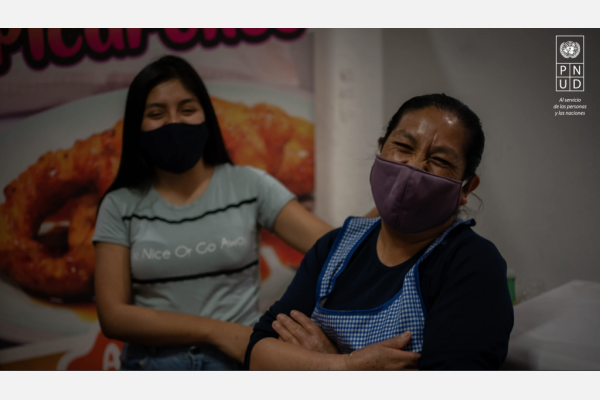Repository of Practices

Warrior Entrepreneur: Contributing to the integration and social cohesion of the refugee and migrant population in Peru
Secondary GCM Objectives
Dates
Type of practice
Summary
Warrior Entrepreneur came to be in April 2020 as a response to the pandemic and the first quarantine that was implemented in Peru, which represented the total shut down of the economy. During this time, many enterprises did not have the tools to adapt to the digital sphere. As a result, many businesses had to shut down. During this context, IKIGAI Social Lab, Me Uno Fundación Backus and UNDP Peru joined forces to create “Warrior Entrepreneur”, a digital training program for entrepreneurs, with the aim of giving them skills and tools to make their business grow during the pandemic. The program lasted 5 weeks, and touched upon subjects like soft skills, how to define the purpose of my business, as well as specific themes like digital marketing, finances, taxes, and so on.
The resources to finance the program included seed capital from UNDP, as well as resources from the private sector, such as INTERBANK and BACKUS. The technical assistance to the entrepreneurs was given by professional volunteers who applied to the program. Volunteers were recruited through social media, and through Volunteering platforms such as Perú Voluntario and Bicentenario. Similarly, the program accepted corporate volunteers from businesses such as Interbank and Backus.
Due to the success of the first few editions, which only included Peruvian entrepreneurs, it was decided to have a special edition called Warrior Entrepreneur: Migrant Edition, which included migrant and refugee entrepreneurs from Venezuela who were also struggling with their enterprise during the pandemic. This special edition included the adaptation of all of the modules to fit the reality of the migrant and refugee population living in Peru, which is different to that of their Peruvian counterparts. This adaptation was especially done within the Finance modules as well as the Formalization ones. From this experience, in which more than 30 entrepreneurs graduated, it was decided to include a percentage of migrant and refugee entrepreneurs in all of the next Warrior Entrepreneur editions with the aim of actively contributing to the social cohesion and integration of the migrant population in Peru, through a program that aims to strengthen the enterprises of all entrepreneurs, regardless of nationality. This is why, since June 2021 all further editions (specifically 2) of Warrior Entrepreneur sought to also recruit and train the refugee and migrant population.
Organizations
Main Implementing Organization(s)
Partner/Donor Organizations
Benefit and Impact
The program included modules that were adapted to fit the reality of migrants, such as those related to the financial sector in Peru as well as formalization bodies. All throughout the program, the integration of migrants was promoted, as well as the social cohesion with the host population, through joint trainings were both groups actively participated and collaborated. The impact of the program on their businesses was measured through an initial and exit survey, through a chatbot called Musa via WhatsApp (all of the information was encrypted, and only used in a confidential manner to draw general and anonymous conclusions about the program). An evaluation 6 months after the program ended was scheduled, yet the migrant population did not answer the survey.
Warriour Entrepreneur will not continue beyond the initial end date. The program was born at the start of the pandemic in March 2020, however, at the end of 2021 the challenges faced by entrepreneurs were much different compared to the previous year. Most entrepreneurs adapted to the digital sphere, by using digital platforms and social media to continue with the operation of their business and to keep reaching new clients, meaning that the theoretical and practical trainings offered by the program were not responding to current demands anymore. Similarly, since Warriour Entrepreneur depends on corporate and professional volunteers, at the end of 2021 much of the economy was open again, and many of the social restrictive measures were eliminated, meaning that people did not have much spare time like they did at the start of 2020 to dedicate to volunteering. These are some of the reasons why Warriour Entrepreneur will not continue with its traditional approach. Instead, it will be adapted to respond to the new challenges faced by entrepreneurs 2 years after the pandemic started, yet this new version is still under construction.
Key Lessons
Recommendations(if the practice is to be replicated)
Innovation
Additional Resources
Media
Guerrero Emprendedor: Liz Garay
Additional Images
Date submitted:
Disclaimer: The content of this practice reflects the views of the implementers and does not necessarily reflect the views of the United Nations, the United Nations Network on Migration, and its members.
More Related Practices:
- Recruitment Cost Calculator (RCC)
- Research on human rights violations against live-in domestic workers, and related Code of Good Practice
- Migration Lab for the domestic and home care sector
- Domestic Workers League of ACV-CSC Brussels
- Ferias y actividades multitudinarias vinculadas a trabajo con organizaciones de base
Peer Reviewer Feedback:
*References to Kosovo shall be understood to be in the context of United Nations Security Council resolution 1244 (1999).
Newsletter
Subscribe to our newsletter.


